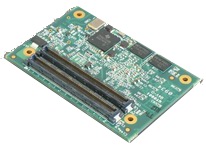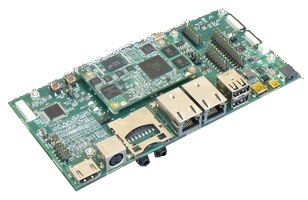Cortex-A8 COM runs Linux
Feb 3, 2010 — by LinuxDevices Staff — from the LinuxDevices Archive — 7 viewsU.K.-based Anders Electronics announced a Linux-ready ARM Cortex-A8 COM (computer on module) with up to 256MB of RAM, 512MB of flash storage, 10/100 Ethernet, and integrated WiFi. The CM-T3530 comes with Texas Instruments OMAP3503 or OMAP3530 CPUs clocked at up to 720MHz, has a touchscreen controller, includes a camera interface, according to the company.
Anders says its new CM-T3530 is available with either the TI OMAP3503 or OMAP3530, clocked at 600MHz or 720MHz respectively. These are low- and high-end versions of TI's Cortex-A8-based OMAP35x system-on-chips (SoCs), first announced in Feb. 2008. As Anders notes, the OMAP3530 not only has a faster clock speed, but also adds an integrated DaVinci TMS320C64x+ DSP and the OpenGL ES 2.0-compatible Imagination PowerVR SGX graphics accelerator.
Like the CM-iAM, an Intel Atom-based COM introduced by Anders in November of last year, the CM-T3530 turns out to have been manufactured by CompuLab of Israel. And once again, the module — which, this time out, measures just 2.6 x 1.73 inches (66 x 44mm) — incorporates two surface-mount CAMI (CompuLabs aggregated module interface) connectors, which convey all signals to and from a separately available baseboard (see later in this story for details).


The top (left) and bottom (right) of the Anders CM-T3530
According to Anders, the CM-T3530 is available with up to 256MB of soldered-on MDDR (mobile DDR) memory, plus an integral flash disk that can be as large as 512MB. Integral touchscreen and graphics controllers support STN and TFT panels with resolutions up to 1400 x 1050 pixels, and a camera interface port is also included, the company says.

A block diagram of the CM-T3530
(Click to enlarge)
Anders says the CM-T3530 is capable of 802.11b/g wireless networking, for which an internal antenna connector is provided via a Marvell 88W8686 chipset. Wired connectivity, via the CAMI connectors, includes a USB host/On-the-Go port, two additional USB 2.0 hosts, three serial ports, up to 74 GPIOs, audio I/O, 10/100 Ethernet, and MMC/SD/SDIO support, according to the company.
Specifications listed by Anders and CompuLab for the CM-T3530 include the following:
- Processor — TI OMAP3503 clocked at 600MHz, or OMAP3530 clocked at 720MHz
- Memory — From 64MB to 256MB of soldered-on mobile DDR; bootable flash disk with 128MB to 512MB of storage
- Display — Supports TFT, STN, or composite displays with resolutions up to 1440 x 1050 pixels; IMAP3530 adds graphics and video acceleration via TMS320C64x+ DSP and PowerVR SGX
- Networking:
- WLAN — 802.11b/g
- LAN — 10/100 Ethernet
- Other I/O (all via CAMI connectors):
- Camera interface
- 1 x USB host/On-the-Go
- 2 x USB 2.0 host
- 3 x serial
- Up to 74 GPIO lines
- Audio — mic in, stereo out
- Power — 3.8VDC; active consumption 0.2 to 2 Watts
- Operating temperature:
- Commercial — 32 to 158 deg. F (0 to 70 deg. C)
- Extended — -4 to 158 deg. F (-20 to 70 deg. C)
- Industrial — -40 to 185 deg. F (-40 to 185 deg. C)
- Dimensions — 2.6 x 1.73 inches (66 x 44mm)
According to Anders and CompuLab, the recommended carrier board for the CM-T3530 is the SB-T35, which measures 6.53 x 3.22 inches (166 x 82mm). The SB-T35 (below) is said to include two Ethernet ports with RJ45 connectors, an S-Video output, an SD/MMC/SDIO socket, plus host and slave USB ports.

The SBT-35 baseboard with the CM-T3530 on board
Availability
According to Anders and CompuLab, the CM-T3530 is available now, with support for both Linux and Windows CE 6.0. Run-time images, board support package (BSP), and a software development kit are all available, according to the companies.
More information on the CM-T3530 may be found on the Anders website, here, and CompuLab website, here. More information on the SB-T35 may be found on the CompuLab site, here.
This article was originally published on LinuxDevices.com and has been donated to the open source community by QuinStreet Inc. Please visit LinuxToday.com for up-to-date news and articles about Linux and open source.